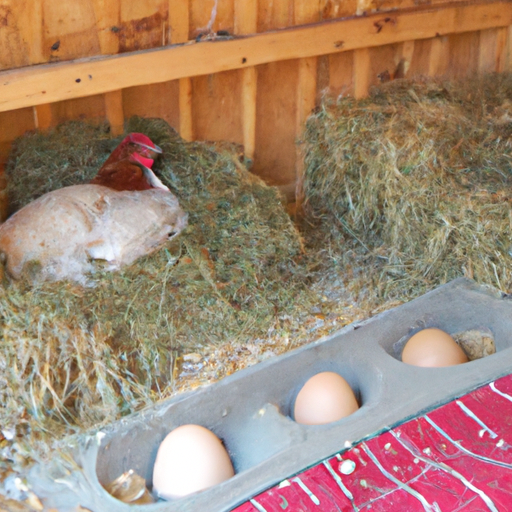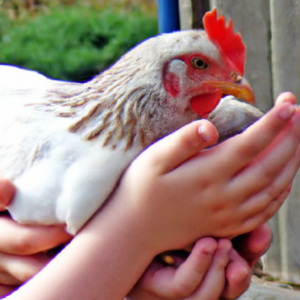
Imagine never having to search for eggs in your backyard again. Picture a serene chicken coop with chickens dutifully laying eggs in a designated spot, making egg collection a breeze. But can chickens really be trained to use a specific area for laying eggs? This curious question has been pondered by many poultry enthusiasts and backyard farmers alike. In this article, we’ll explore the possibility of training chickens to adopt a particular area for their egg-laying endeavors and uncover some helpful tips and tricks to encourage this behavior. With a dash of patience and a sprinkle of ingenuity, you might just be able to transform your chicken coop into an egg-hunting sanctuary.

Benefits of Training Chickens to Use a Specific Area for Laying Eggs
Increased Egg Collection Efficiency
Training chickens to use a specific area for laying eggs can greatly increase the efficiency of egg collection. When chickens are trained to lay eggs in a designated spot, it makes it much easier for farmers or backyard chicken keepers to locate and collect the eggs. This saves time and effort that would otherwise be spent searching for eggs in various areas of the coop or yard.
Reduced Risk of Egg Loss or Damage
By training chickens to lay eggs in a specific area, there is a reduced risk of egg loss or damage. When eggs are scattered throughout the coop or yard, they may be more prone to getting misplaced, cracked, or even eaten by other animals. Having a designated egg-laying area ensures that the eggs are kept together and are less likely to be damaged or lost.
Easier Nest Box Maintenance
Training chickens to use a specific area for laying eggs makes nest box maintenance much easier. When chickens have a designated spot for laying eggs, it is easier to keep that area clean and tidy. Regular cleaning of the nest boxes becomes a simpler task, as there is only one area to focus on rather than multiple scattered nests. This promotes better hygiene and reduces the risk of diseases or parasites affecting the eggs.
Understanding the Natural Nesting Behavior of Chickens
Nesting Behavior in Wild Chickens
In the wild, chickens have a natural instinct to find hidden and secluded spots to build their nests and lay their eggs. They look for areas that provide security, privacy, and protection for their eggs. This behavior helps ensure the survival of the offspring by keeping the eggs safe from predators and harsh environmental conditions.
Nesting Behavior in Domesticated Chickens
Although domesticated chickens have inherited some of the nesting instincts from their wild ancestors, their nesting behavior can be influenced by various factors. In some cases, chickens may choose to lay eggs in random areas, which can be inconvenient for egg collection and maintenance. However, domesticated chickens can be trained to recognize and utilize a specific area for their egg-laying needs.
Importance of Mimicking Natural Nesting
When training chickens to use a designated area for laying eggs, it is important to mimic their natural nesting preferences as closely as possible. This means providing a comfortable and safe environment that meets their instinctual needs. By understanding the natural nesting behavior of chickens, we can create an environment that encourages and supports their egg-laying instincts.
Training Chickens to Recognize the Designated Egg-Laying Area
Selecting the Location for the Designated Area
Choosing the right location for the designated egg-laying area is crucial for successful training. It should be a quiet, secluded, and relatively undisturbed area where chickens feel safe and comfortable. Ideally, it should be away from high traffic areas, loud noises, or potential disturbances from other animals. Observing the chickens’ behavior and preferences can help determine the most suitable location.
Creating a Comfortable and Safe Nesting Environment
To encourage chickens to use the designated area, it is important to create a comfortable and safe nesting environment. This can be achieved by providing appropriate nesting materials, such as straw or wood shavings, to mimic the natural bedding found in the wild. Additionally, ensuring proper ventilation, lighting, and temperature control in the area can enhance their comfort and encourage them to choose it as their preferred nesting spot.
Consistency in Nest Box Placement
Consistency in nest box placement is key to successfully training chickens to recognize the designated egg-laying area. Once the location has been chosen, it is important to maintain the position of the nest boxes or nesting area. Avoid moving or relocating the nest boxes unless necessary, as this can confuse the chickens and disrupt their nesting routine. Consistency helps establish a sense of familiarity and reinforces the desired behavior.

Encouraging Chickens to Use the Designated Area
Providing Adequate Nesting Resources
To encourage chickens to use the designated egg-laying area, it is essential to provide them with adequate nesting resources. This includes placing nesting boxes or designated nesting areas with comfortable and suitable bedding materials, as well as providing enough space for each chicken to comfortably access the nesting area. Ensuring there are enough nesting areas available helps prevent overcrowding or competition among the chickens.
Establishing a Routine for Egg Collection and Nest Cleaning
Establishing a routine for egg collection and nest cleaning can greatly encourage chickens to use the designated area. Regularly collecting eggs from the designated spot sends a clear message to the chickens that this is where they should be laying their eggs. Cleaning the nest boxes or area regularly helps maintain hygiene and prevents the accumulation of dirt or debris that could discourage the chickens from using the area.
Addressing Common Challenges in Training Chickens
Resistance to Nest Box Training
Resistant chickens may not immediately adapt to the idea of using a designated nest box or area. Patience and consistency are key when addressing this challenge. Providing extra encouragement, such as placing a few eggs in the nest box or lightly blocking off alternative nesting sites, can help guide the chickens towards the desired area.
Competitive Nesting Behavior
In situations where multiple chickens are vying for the same nesting box or area, competitive nesting behavior can occur. To address this challenge, it is important to provide enough nesting resources to accommodate all the chickens. Adding additional nesting boxes or creating multiple designated areas can help reduce competition and encourage each chicken to find their preferred spot.
Preventing Egg Eating or Brooding
Egg eating or brooding can be a common challenge when training chickens to use a specific area for egg-laying. To prevent these behaviors, it is important to promptly collect eggs from the designated area to discourage hens from developing a habit of eating or brooding on the eggs. Ensuring adequate nutrition and providing distractions, such as environmental enrichment, can also help redirect their focus away from these behaviors.
Benefits of Using Communal Nesting Boxes
Increased Social Bonding among Hens
Using communal nesting boxes can promote increased social bonding among hens. When multiple chickens share the same nesting area, they have the opportunity to interact, communicate, and establish hierarchies within the flock. This social interaction can contribute to a healthier and more cohesive flock dynamic.
Improved Nest Box Utilization
Communal nesting boxes often result in improved nest box utilization. Chickens tend to follow the lead of their flock mates and may prefer to lay their eggs in the same area. This can lead to more consistent egg-laying patterns and easier egg collection for the chicken keeper.
Preventing Nest Box Hoarding
Having communal nesting boxes helps prevent nest box hoarding by individual chickens. Some chickens may try to claim a nesting box as their own and prevent others from using it. With communal nesting boxes, each chicken has an equal opportunity to find a space for laying eggs, reducing conflicts within the flock.
Alternative Methods for Managing Egg Laying
Free-Range Systems
Free-range systems allow chickens to roam freely and choose their own egg-laying spots. While this provides a more natural environment for the chickens, it can make egg collection and maintenance more challenging. It requires diligent searching for eggs and monitoring for potential hidden nests.
Confinement Systems with Individual Nest Boxes
Confinement systems with individual nest boxes provide each chicken with their own private space for laying eggs. This reduces the risk of competition and egg eating, but it may require more space and resources to accommodate each chicken’s individual needs.
Combining Training Methods for Maximum Efficiency
For maximum efficiency, it is possible to combine training methods to manage egg laying. By providing a designated area and communal nesting boxes, chickens can have a preferred spot while also having access to additional options. This offers flexibility and caters to individual chicken preferences.
Maintaining Hygiene and Nest Box Cleanliness
Frequent Cleaning and Disinfection
Maintaining hygiene and cleanliness in the nest boxes is crucial for the health of the chickens and the quality of the eggs. Regularly cleaning and disinfecting the nest boxes helps prevent the spread of diseases and minimizes the risk of contamination. Removing soiled bedding, feces, and other debris should be done frequently to ensure a clean nesting environment.
Using Appropriate Bedding Materials
Using appropriate bedding materials in the nest boxes is essential for maintaining cleanliness and comfort. Straw or wood shavings are commonly used bedding materials that help absorb moisture and provide insulation. Avoid using materials that are toxic or can harbor bacteria. It is important to replace the bedding regularly, especially if it becomes soiled or wet.
Monitoring for Signs of Parasites or Diseases
Regular monitoring of the nest boxes and the chickens is necessary to detect any signs of parasites or diseases. Infestations of mites, lice, or other pests can occur in nest boxes, jeopardizing the health of the chickens and the eggs. Prompt identification and appropriate treatment are crucial to maintaining a healthy nesting environment.
Signs of a Successful Training Program
Consistent Egg Laying in Designated Area
A successful training program can be observed when chickens consistently lay their eggs in the designated area. By following the training techniques and providing an ideal environment, chickens should naturally recognize and utilize the designated spot for their egg-laying needs. Consistent egg laying in the designated area is a sign that the training has been effective.
Improved Egg Quality
Training chickens to use a specific area for laying eggs can result in improved egg quality. Eggs laid in a clean and controlled environment are less likely to be damaged, contaminated, or develop abnormalities. By providing a designated egg-laying area, the eggs are better protected and can maintain their quality and freshness.
Reduced Stress or Aggression among Hens
A successful training program can also lead to reduced stress and aggression among hens. When chickens have their own preferred spots for egg-laying and ample resources, they are less likely to engage in aggressive behaviors or conflicts with other flock members. This can create a calmer and more harmonious environment for the chickens.
Conclusion
Training chickens to use a specific area for laying eggs offers numerous benefits, including increased efficiency in egg collection, reduced risk of egg loss or damage, and easier nest box maintenance. Understanding the natural nesting behavior of chickens and mimicking it in the designated area helps encourage chickens to recognize and utilize the desired spot. Addressing common challenges, considering alternative methods, and maintaining hygiene are important factors in successfully training chickens. By implementing these strategies, chicken keepers can create a more organized and productive egg-laying system while promoting the well-being of their flock.







